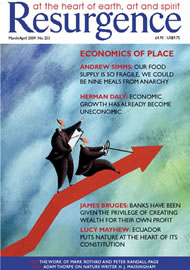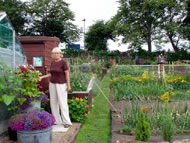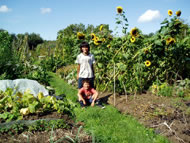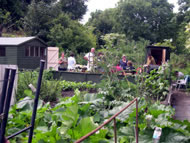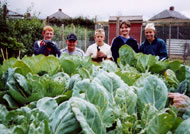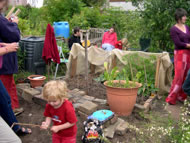THE VISION OF the Scottish Allotments & Gardens Society (SAAGS) is that everyone in Scotland should have the opportunity to garden within ten minutes’ walking distance of their dwelling and that allotment sites are the hub of community engagement and action. However in order for allotment provision to even begin to fulfil this vision we must overcome the negative image that the word ‘allotment’ evokes in some people. Recently a Glasgow Councillor wrote “I do not believe that allotments would add to the amenity of the locality. They would be visually unattractive and occupy land which should be open and accessible to the public in order to maximise community benefit.” The whole allotments movement is changing but there is still an embedded view of allotments as closed, private fiefdoms for old men.
Therefore we have started to use the word 'Kara' meaning a beloved community space for cultivation. A typical Kara has individual allotment plots, access gardens, orchards, wildlife areas, community meeting places and a play area for the children. It is a richer, more diverse growing space that has sprung out of the traditional sites. Karas offer one of the best opportunities for sustainable development: growing your own crops provides a source of healthy and potentially organic food, creates a great place to compost and use organic matter and can reduce food miles dramatically. As well as increasing healthy active lifestyles, social interaction is improved across the allotments and through the distribution of surplus. Perhaps most importantly it brings us back into contact with the value of Nature and biodiversity.
The big issue is access to land. There is now a recognition of the value of allotments from government and many local authorities who have a legal duty to provide allotments if six electors ask for them and the need is identified. However, despite long waiting lists for allotments, at present there are only about 6300 plots throughout Scotland. There is a hunger for land to garden across Scotland with a need for new sites and a strong strategy for action.
IN ORDER TO gain practical support for the Karas movement from the Scottish government and local authorities (SAAGS) needed to show how allotments contribute to the government’s own agenda of a Scotland that is Wealthier and Fairer, Smarter, Healthier, Safer and Stronger and Greener. Analysing where Karas sit within this framework, explicitly showing their value to these objectives has provided a common basis for discussions with government ministers and officials from different departments and has proved useful for the Karas movement as well, strengthening our understanding of our role in communities and the wider natural environment.
The obvious objective that Karas contributes to is ‘Greener’. With climate change and environmental degradation on the agenda, gardening is a creative, positive contribution that ordinary people can make to carbon reduction and climate adaptation. To enable more people to participate, the design of allotments has changed. Instead of rows of individual plots all about 200m2, there are a variety of spaces shaped by the people who work them. Keen gardeners can still tend traditional sized plots - sufficient to provide the vegetables for a family of four all year; others have smaller areas with maybe room for a fruit tree or a few soft fruit bushes and then there are herb or flower patches for those who want to grow something but have little time. The needs of local wildlife are not forgotten with hedges, ponds, compost heaps and boundary trees. At the centre of larger sites are areas for meeting, talking and celebrations of gardening culture and art: community spaces where new initiatives for adapting to climate change can grow.
But it in fact, Karas meet all the objectives in varying ways. A ‘Fairer’ society is achieved by creating an opportunity to garden within the local community. Karas address the social justice issue of access to the natural world and to fresh food. Action groups and new schemes are rising almost daily with over fifty new groups seeking land across Scotland. Many of the new ‘transition towns’ proposals include Karas.
Meanwhile, healthcare providers are considering the contribution gardening makes to wellbeing. Just weeding a small seed-bed with the sun shining and the birds singing reduces stress in many people. Lothian Health Board, for example, funds six plots and a community gardener in a new site in Edinburgh. They plan to roll this out across more sites and are looking to provide land for Karas in hospital grounds.
In helping create a ‘Smarter’ Scotland, Karas give a wonderful opportunity for life-long learning. Several allotment sites are linked to their local schools with plots for the pupils. Most schools are now part of the ‘Eco-school scheme’ and many find the support and help of plot-holders to be invaluable. Teachers often do not have gardening skills but by linking to a local allotment, lessons can be built round the garden and produce is taken back for the school kitchen or for enterprise projects. The older generation learned to garden from their parents but these skills have been lost in many families. An allotment site enables plot-holders to watch what others grow and information travels quickly round a site. An old, experienced gardener can show the solid foundations of gardening while a young enthusiast can bring new techniques and different plants. On my site someone grew green manure and the next year one third of the plots had a crop. Seven years ago there were no small fruit trees now they abound, with pears, plums and cherries and apples.
A ‘Safer and Stronger’ Scotland is rooted in the idea of viable communities. The heart of a traditional allotment is the plot-holders community. It is usually very strong and supportive (although at times conflicts can occur). Karas have now grown this community-ethos outwards to encompass the wider community with links to schools, GPs and diverse groups. Bringing together all these people in a working, sharing environment helps sustain a vibrant, safer and stronger local community.
Karas are spreading across Scotland. Already there are schemes to regenerate backyards with herbs and shrubs, to create flowerbeds in play parks and along walkways, to enable school grounds to flourish with vegetable plots and community gardens and small orchards abound. The culture of growing is changing and Scotland is becoming a community of gardens and orchards.




